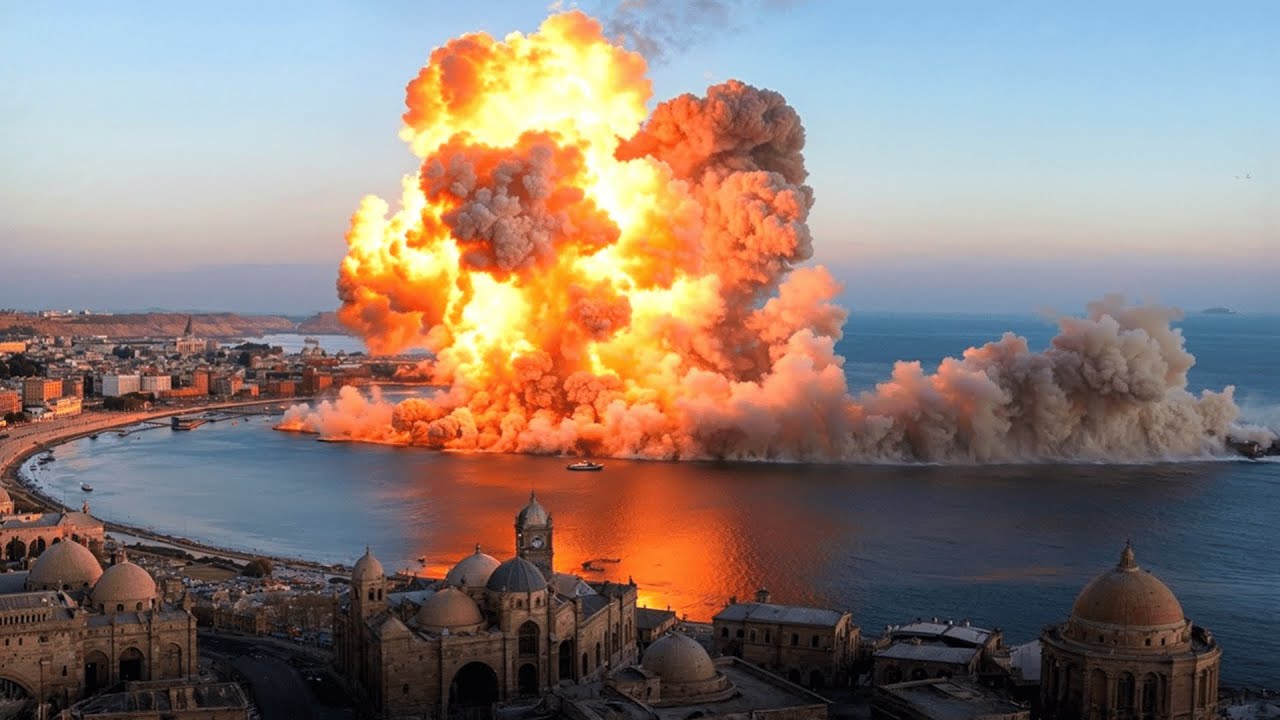US 30,000-Pound Bunker Buster Will Level Iran in seconds!
A major unknown we have been discussing for
many years is how Israel would go about fully destroying Iran’s nuclear capabilities, not
just degrading them, without having the ability to penetrate deeply buried sites from the air —
the nuclear enrichment facility that sits under a mountain in Fordo, in particular. Without the help
of U.S. B-2 Spirits carrying 30,000-pound GBU-57/B Massive Ordnance Penetrator (MOP), a ground
operation seemed like nearly the only option. The U.S. military is positioning
B-2 stealth bombers at Diego Garcia, signaling potential strikes against Iran amid
heightened tensions. Historically cautious, America’s approach to Iran seems to be changing
under President Trump, especially after recent Iranian provocations, nuclear advancements,
and direct attacks against Israel. However, attacking Iran is complex, requiring
extensive bombing missions to disable Iranian defenses first. Israeli precision strikes
demonstrate effectiveness, but risks remain. Key indicators of imminent action would
include relocating U.S. aircraft carriers away from vulnerable positions in the Persian Gulf,
signaling readiness for sustained operations. Secretary of Defense Pete Hegseth has ordered
advanced B-2 stealth bombers to the U.S. base in the Indian Ocean archipelago of Diego Garcia.
In the midst of escalating tensions between the United States and Iran, the B-2 Spirit stealth
bomber’s capabilities are under intense scrutiny. As the world watches with bated breath, one
critical question dominates the conversation: Can the B-2 Spirit’s advanced stealth
technology evade detection by Iranian missiles and emerge unscathed.
The B-2 Spirit, often called the “stealth bomber,” is a marvel of American engineering,
designed to penetrate the most sophisticated air defenses undetected. Built by Northrop
Grumman, it first took flight in 1989 and entered service with the U.S. Air Force in 1997.
With a distinctive flying-wing shape and radar-absorbing materials, the B-2 is nearly
invisible to enemy radar, a capability that comes at a steep price—each plane costs over $2
billion to produce, making it one of the most expensive aircraft ever built. Only 21 were
constructed, and today, fewer than 20 remain operational due to a crash in 2008.
The B-2’s ability to carry a range of precision-guided munitions, including the B61
nuclear bomb and the JDAM-ER, would be a critical factor in any conflict. The aircraft’s stealth
capabilities and advanced avionics would allow it to penetrate deep into enemy airspace and
deliver its payload with precision. However, the mission would still be extremely
challenging, with Iranian air defenses working together to provide comprehensive coverage.
The bomber’s range exceeds 6,000 nautical miles without refueling, extendable to over 10,000 with
midair refueling, allowing it to strike targets across the globe from bases like Diego Garcia. Its
payload is equally impressive, capable of carrying up to 40,000 pounds of ordnance, including
conventional bombs and the massive GBU-57 Massive Ordnance Penetrator, a 30,000-pound weapon
designed to destroy deeply buried targets. However, Iran’s air defenses are a complex network
of surface-to-air missile systems, radar stations, and command centers. The Bavar-373, in
particular, is a long-range, road-mobile system capable of detecting and intercepting
stealth aircraft. Its Sayyad-4 missiles have a range of up to 300 km and can engage targets
at altitudes of up to 27 km. The system also features a phased array radar for tracking
aerodynamic targets and ballistic missiles. To counter Iran’s formidable air defenses, the
US would likely deploy a range of supporting assets. Electronic warfare aircraft, such
as the EA-6B Prowler or the EA-18G Growler, would jam Iranian radar systems, creating a
window of opportunity for the B-2 to penetrate enemy airspace. Fighter jets, like the F-15E
Strike Eagle or the F-22 Raptor, would provide air cover and engage Iranian aircraft.
In the event of a conflict, the B-2 Spirit’s stealth capabilities would be put to the ultimate
test. The aircraft’s ability to evade detection by Iranian missiles would be critical to its
survival. The US would need to carefully plan and execute its attack, taking into account Iran’s
air defenses and potential retaliatory measures. The stakes are high, and the outcome uncertain,
but one thing is clear: the B-2 Spirit’s stealth capabilities will be pushed to their limits
in a high-stakes conflict with Iran. Although the B-2’s stealth capabilities are
considered increasingly out of date, with the bomber having entered service in 1997, the
limitations faced by Iran’s air defence network, and the aircraft’s unique ability to drop GBU-57
Massive Ordnance Penetrator bombs that are particularly well suited to neutralising
fortified bases and nuclear facilities, make the bombers highly valued. The bombers’
long ranges also significantly reduces the risk that bases hosting them could be targeted
in Iranian missile and drone strikes, which is a major threat to American tactical aviation assets
such as F-35 stealth fighters in the region. Although Iran’s ability to detect and
neutralise stealth bomber attacks is expected to be significantly improved with the
delivery of Su-35 fighter aircraft from Russia, which will provide it with a particularly
large array of modern elevated sensors, these aircraft have yet to be delivered to the
country. Iran’s current fleet of over 17 squadrons of fighter aircraft is considered largely
obsolete for air-to-air operations, with the majority of aircraft using Vietnam War era sensors
poorly suited to targeting stealth aircraft. In this campaign, the B-2’s role has centered
on attacking the Houthis’ underground bunkers, a task that leverages its ability to deliver
heavy, precision-guided munitions. Former Defense Secretary Lloyd Austin confirmed a similar mission
in October 2024, when B-2s hit five hardened weapons storage sites in Yemen, showcasing their
capacity to tackle fortified structures. The GBU-57, often cited in such operations, can
penetrate up to 200 feet of earth or 60 feet of concrete before detonating, making it ideal for
targeting the kind of subterranean facilities the Houthis have developed with Iranian assistance.
Compared to other U.S. bombers like the B-52 Stratofortress or B-1 Lancer, the
B-2’s stealth gives it a unique edge, allowing it to operate in contested airspace
where older platforms might be vulnerable. Russia’s Tu-160 or China’s H-6, while formidable,
lack this level of radar evasion, underscoring the B-2’s singular place in modern warfare.
However, the choice of the B-2 for this mission reveals as much about the target as it does about
the aircraft. The Houthis’ reliance on underground storage suggests a level of sophistication
that goes beyond a typical militia. These bunkers, likely reinforced with
concrete and dispersed across rugged terrain, are a testament to years of Iranian
support, which has included not just weapons but also engineering expertise.
The Air Force has leaned on the B-2’s unique strengths, but its scarcity limits how often
it can be risked. By contrast, Russia’s mass airstrikes in Syria or China’s saturation
tactics with cheaper platforms offer different models for dealing with irregular forces, though
neither matches the B-2’s surgical precision. The Houthis’ ability to endure suggests that
airpower alone, even from a platform as advanced as the B-2, may not suffice against an enemy
that adapts faster than it can be destroyed. Looking ahead, this operation could shape the
future of stealth warfare. The B-2’s successor, the B-21 Raider, is already in development,
promising lower costs and greater numbers—Northrop Grumman aims to build at least 100, with
the first test flight completed in 2023. Unlike the B-2, designed in the Cold War to
evade Soviet radar, the B-21 is tailored for a world of drones, cyber threats, and dispersed
enemies like the Houthis. Its smaller size and projected $700 million-per-unit cost could
make it a more practical tool for conflicts where the B-2’s expense feels disproportionate.
Yet, the current campaign tests that logic. If a handful of B-2s, backed by billions in munitions,
can’t decisively cripple a militia, what does that say about the next generation of stealth
bombers? The Air Force might argue that the B-21’s versatility—potentially including unmanned
options—will close that gap, but Yemen offers a sobering preview of the challenges ahead.
if you enjoy content like this please go ahead and like And subscribe to this video
because I appreciate all your support.
US 30,000-Pound Bunker Buster Will Level Iran in seconds!
U.S. Air Force B-2 Spirit stealth bombers dropped 14 30,000-pound GBU-57/B Massive Ordnance Penetrator (MOP) bunker buster bombs on Iran’s Fordow and Natanz nuclear facilities. The attack marked the first operational use of the constantly evolving MOP are the only known combo of conventional weapons that could theoretically dig down far enough to blow up the Fordow nuclear site.
In today’s video, we will discuss the promising capabilities of this aircraft and take a closer look at the facts that support its existence.
✅ NB : Thumbnails and Titles are for illustration only
© Copyright Disclaimer Under Section 107 of the Copyright Act 1976, allowance is made for “fair use” for purposes such as criticism, comment, news reporting, teaching, scholarship, and research. Fair use is a use permitted by copyright statute that might otherwise be infringing. Non-profit, educational or personal use tips the balance in favor of fair use.
#americantechnology








2 Comments
TT Trump ra lệnh đánh vào những nơi Iran chế tạo vũ khí hạt nhân không còn gì 👍.
Máy bay ném bom tàng hình B2 không quân Hoa Kỳ. Hết sức tuyệt vời OK 🇺🇸👍.